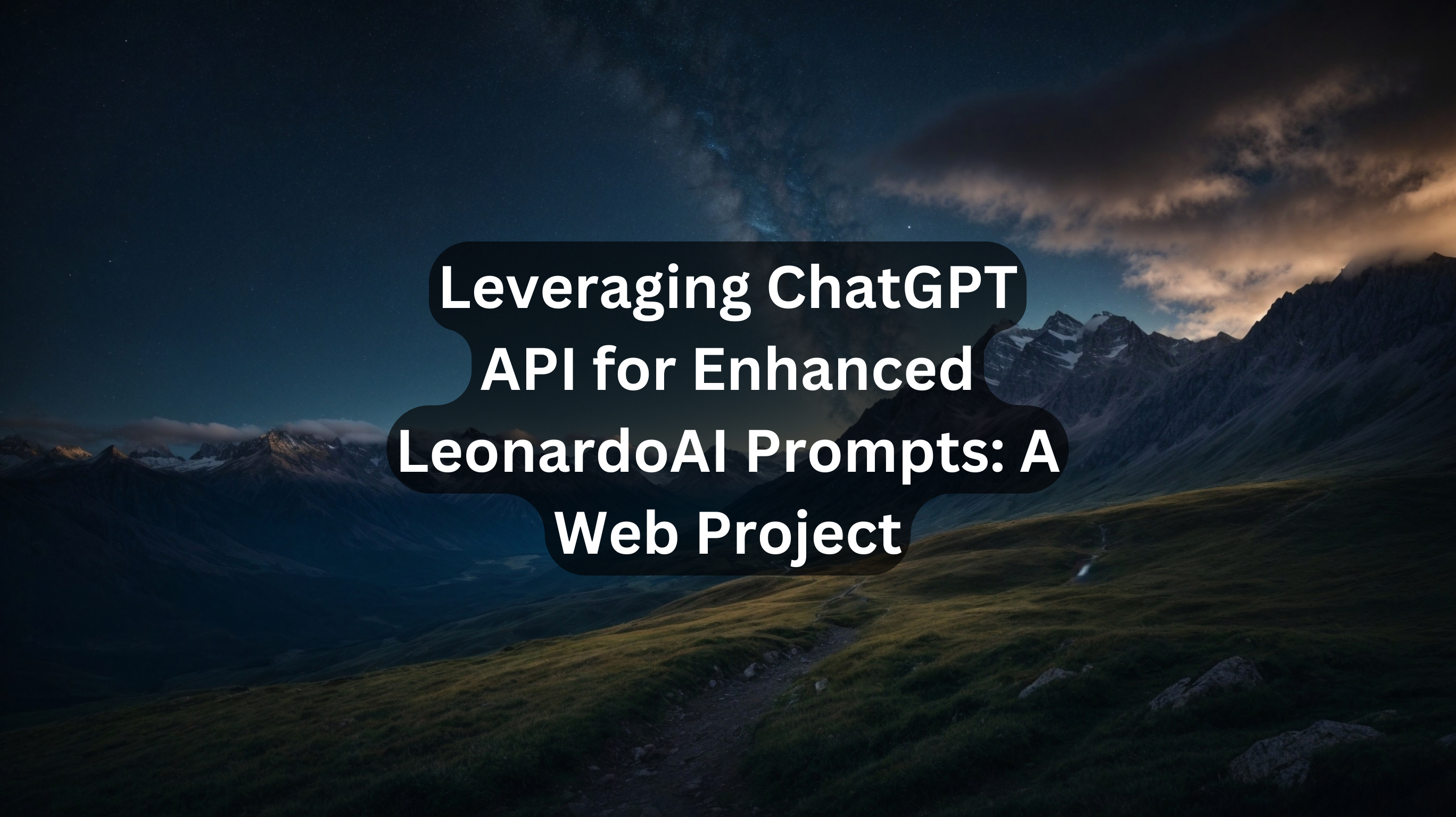Leveraging ChatGPT API for Enhanced LeonardoAI Prompts: A Web Project
 Chris
Chris
I'm thrilled to delve into the specifics of my recent web application, a platform that synergizes the capabilities of LeonardoAI and ChatGPT. The central objective of this project is to offer users an optimized environment where they can transform simple text queries into intricate, aesthetically pleasing images. If you'd like to skip the explanation, feel free to check out the web application here, or the source code here.
The Problem
Traditionally, generating high-quality images has necessitated considerable effort in adjusting both positive and negative prompts to minimize issues such as noise and typical StableDiffusion problems like malformed facial features or hands. This level of manual tweaking is far from ideal, particularly when the goal is to employ generative content as a substitute for costly licensed stock photography in web-based applications.
The Inspiration
My prior work on optimizing LeonardoAI/StableDiffusion prompting through ChatGPT illuminated the potential for a unified platform. This platform would eliminate the manual labor involved in transferring prompts between separate interfaces. The convenience of leveraging ChatGPT to autonomously optimize prompts is invaluable, especially in scenarios where automated generative content is desired, and there is a need to trust that the resulting images will be free from common defects like multiple limbs or blurred areas.
The Objectives
Automation: Reduce the manual effort needed for refining image generation prompts by capitalizing on large language models like ChatGPT.
Customization: Enable users to bring their ideas to life in image form, without the need to articulate their vision in excessive detail.
Efficiency: Consolidate the capabilities of various AI tools into a single, streamlined workflow.
The Application
In essence, the web application acts as an intermediary between LeonardoAI, ChatGPT, and the user. The platform employs fine-tuned "pre-prompting" techniques to translate straightforward ideas into optimized StableDiffusion prompts. These optimized prompts are then automatically sent to LeonardoAI for image generation.
The Tech Stack
Building a web application requires a well-thought-out selection of web technologies. For this project, I opted for Nuxt3 as the full-stack framework, complemented by DaisyUI—a UI framework based on TailwindCSS—for an intuitive and visually appealing layout.
Why Nuxt3?
Nuxt3 was a natural choice for a multitude of reasons, not the least of which is its robustness in rapid prototyping and development. Built on the foundation of Vue.js, Nuxt3 allows developers to effortlessly transition from idea to implementation. Moreover, it takes care of complex issues that often slow down development, such as speed optimization and SEO, right out of the box.
The Power of LeonardoAI
I selected LeonardoAI as the image generation engine for several compelling reasons. Foremost among these is its simplicity, making it easy to integrate and use. Yet, perhaps its most valuable asset lies in its extensive library of custom-trained models. This enables users to not just create images, but to select from a variety of art styles that are already optimized—a feature that dovetails perfectly with the highly specialized prompts generated by ChatGPT.
The Role of ChatGPT
Choosing ChatGPT for text generation and optimization was a straightforward decision. As the market leader in its domain, it has proven capabilities for tackling an array of specific tasks programmatically. My familiarity with the platform further added to its appeal, making it an indispensable part of this project.
Harnessing the ChatGPT API: System Prompts and Beyond
Introduction to ChatGPT's API
ChatGPT's API opens up a myriad of opportunities for developers to fine-tune how the model interacts with users in a more controlled and predictable manner. While the default behavior on the ChatGPT website can produce varied outputs, it's often not as reliable for specialized tasks. This is because its default system prompt configures it as a conversational AI, making it less optimal for functioning as a precision-tuned generative model.
Guiding GPT with System Prompts
System prompts act as overarching instructions that steer ChatGPT's behavior during interactions. For instance, by setting a system prompt that configures the model as a pirate, ChatGPT will respond in pirate lingo. This level of control is invaluable when using ChatGPT to generate specialized prompts for LeonardoAI. Though I won't delve into code specifics in this post, I'll explore the nuances of optimizing the ChatGPT API in an upcoming article. Stay tuned!
User and Assistant Prompts for Focused Outputs
ChatGPT's API allows for the inclusion of pre-set conversation messages. These "user" and "assistant" prompts serve as artificial dialogues that further dictate how ChatGPT should generate responses. By providing these example dialogues, we can more precisely control the type of optimized prompts ChatGPT produces, while clarifying its role in the workflow.
Practical Application in Our Project
Within the context of our web application, I've taken full advantage of the ChatGPT API's capabilities to yield consistent, system-like outputs in a predictable manner. This approach also paves the way for future enhancements, such as generating not only "positive" prompts for StableDiffusion but also "negative" ones. For example, ChatGPT can be guided to focus on elements that typically challenge StableDiffusion, like intricate details of fingers or facial features.
Introducing the Final Product: LeonardoGPT
I'm thrilled to unveil LeonardoGPT, a merger of two of the best generative platforms in the industry. If you're curious to delve into the nitty-gritty details, the source code is available for your perusal here.
What's Next?
The journey doesn't end here. I have an array of exciting ideas in the pipeline for leveraging ChatGPT in even more creative ways. So, keep an eye out for future updates as we continue to evolve and expand this project into something truly epic!
Subscribe to my newsletter
Read articles from Chris directly inside your inbox. Subscribe to the newsletter, and don't miss out.
Written by
